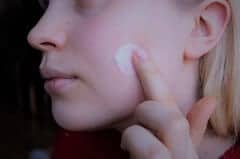For many women, their “going out” routine looks a little something like this: put together an amazing outfit, craft a great hairstyle and, using all the right skin care products and cosmetics in your arsenal, make up your face into one that’s picture perfect.
But what many of us don’t realize is that this beautifying ritual also includes painting on, combing in or otherwise applying a wide variety of bacteria onto our face, eyes and lips via the beauty products and cosmetics we use.

Beginning with the at-home face cleansing ritual, you’ll find that most beauty experts recommend washing one’s face and applying face creams with hands and fingers over brushes or washcloths. Fingertips are excellent for promoting circulation through facial massage and just gentle enough not to cause damage to your skin, but only if you wash your hands first. It’s considered both necessary and sanitary to wash your hands after using the restroom and before preparing or eating food, but scientists say it’s just as imperative that we extend the practice of washing our hands prior to applying skin care and makeup products.
Washing your hands before applying face wash, cleanser or skin moisturizer lessens the chance of contaminating a product by continually dipping your fingers into it. It also prevents the transfer of dirt and bacteria from your fingertips to your face.
Related: How to Achieve the 10-Step Korean Skincare Routine
“Wash hands before applying cosmetics, close cases or jars after use, read cosmetic labels carefully and replace as directed, replace applicators frequently, or use disposable makeup applicators,” recommends Personal Care Products Council senior microbiologist John F. Krowka. Keeping clean hands can help us regain control over what might be growing in our personal beauty products.
When in doubt, always use a spoon to scoop out moisturizer, or purchase products which feature an airless pump for a cleaner alternative.

Contaminated products can also lurk in places where our makeup is purchased from, like at the cosmetic counter of a department store or makeup specialty store. More specifically, it’s the one place you stop by to see if that shade of red is really you, or if you can pull off a dramatic, smokey eye — the makeup tester area.
As fun as this area can be, it also happens to be one of the filthiest. During my college days working in retail, I watched in awe as dozens of women came into shops without makeup who gave themselves daily, complete makeovers in minutes, all using products in the tester areas. Many of these women indulged in this habit without spending a dime on any cosmetic purchases, and most of them did so without properly sanitizing the tester items (or asking an employee to do so) first. There’s a good reason why you should always sanitize tester items before using them.
Related: Beauty Products for Black Women Have a Higher Chance to Be Toxic
Back in 2004, a researcher named Elizabeth Brooks was curious about what type of bacteria and germs lived within the tester bottles of department stores. After conducting a study in which she took cultures of what was inside these bottles, she found E.coli, staph and strep bacteria growing inside most of them.
Brooks also found that over a three-day period, from Friday through Sunday, the level of contamination grew, most likely because of varying levels of foot traffic the store received throughout the weekend. By Friday the tester bottles were 67 percent contaminated; by Saturday they were 80 percent contaminated; by Sunday, the contamination rate of all tester products was 100 percent.

This makeup-bacteria connection continues long after we’ve selected, purchased and taken our products home. It even extends to how long we keep our cosmetics. Beauty experts say it’s safe to use eye and lip pencils up to two years, because the frequent sharpening keeps them sanitary. Lipsticks, lip glosses, foundation and concealer can last about a year before you need to toss them out. Liquid eyeliner can be used for as long as four months, but mascara should only be used for three months.
Most women tend to use makeup products until they’re gone. Because of the cost many consumers pay for their cosmetics, especially high end ones, most find it wasteful not to do so. Another study which surveyed nearly 4,000 women found that nearly 90 percent hoard cosmetics well past their expiration date. In the scheme of it, it’s much safer to toss them than to risk your health by continuing to use them.

Cosmetics like mascara sometimes undergo a change in appearance, consistency and odor after their expiration date. These are all indicators that these items should be replaced as soon as possible. Another study, published in the International Journal of Cosmetic Science, used two Brazilian universities to examine what kind of bacteria grew in expired mascara samples from 44 women. Staph was found in 79 percent of the samples.
When it comes to safety and beauty, this cleanliness ritual isn’t just about the makeup we use; it must also extend to the tools we use to apply our makeup. Brushes should be cleaned at least once a month while sponges, cloths and other application accessories need to be washed on a daily basis. If you’re not up for frequent washing, opt for disposable makeup applicators. The sterility of your makeup, not to mention your overall health, could very well depend on it.
Ronke Idowu Reeves is a writer and journalist who hails from Brooklyn, NY. Her news and entertainment stories have appeared on WABC-TV-New York, Fox News Channel, VH1, BET.com plus in Sundance Film Festival’s Sundance Daily Insider and People Magazine.


![How To: ‘Fix’ Crepey Skin [Watch]](https://cdn.vitalupdates.com/wp-content/uploads/2017/05/bhmdad.png)












